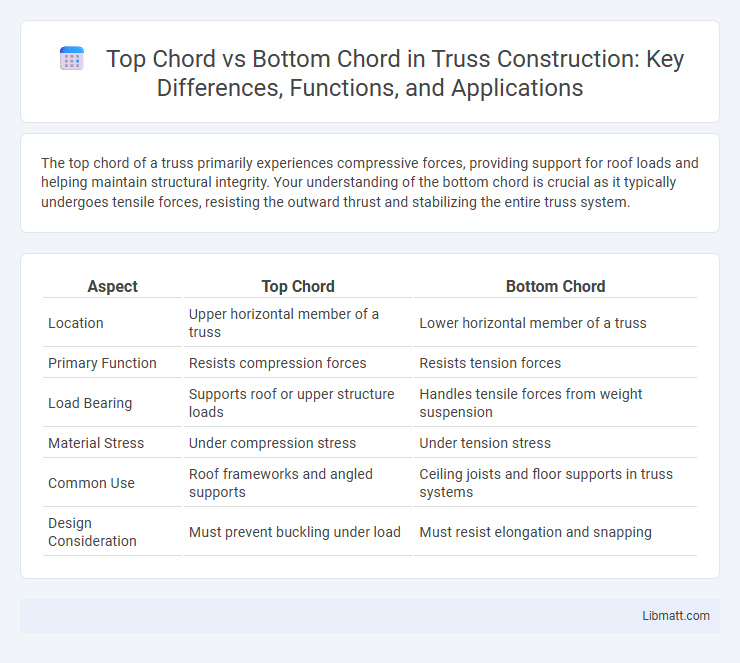The top chord of a truss primarily experiences compressive forces, providing support for roof loads and helping maintain structural integrity. Your understanding of the bottom chord is crucial as it typically undergoes tensile forces, resisting the outward thrust and stabilizing the entire truss system.
Table of Comparison
| Aspect | Top Chord | Bottom Chord |
|---|---|---|
| Location | Upper horizontal member of a truss | Lower horizontal member of a truss |
| Primary Function | Resists compression forces | Resists tension forces |
| Load Bearing | Supports roof or upper structure loads | Handles tensile forces from weight suspension |
| Material Stress | Under compression stress | Under tension stress |
| Common Use | Roof frameworks and angled supports | Ceiling joists and floor supports in truss systems |
| Design Consideration | Must prevent buckling under load | Must resist elongation and snapping |
Introduction to Truss Components
The top chord of a truss is the upper horizontal or sloped member that primarily experiences compression forces, providing structural stability and supporting roof loads. The bottom chord runs parallel to the top chord and mainly undergoes tension, acting as the tie that resists outward forces and maintains the truss's shape. Both chords are critical components in distributing loads efficiently and ensuring the overall performance of the truss system in building frameworks.
What is a Top Chord?
A top chord is the uppermost horizontal or inclined member of a truss structure that primarily carries compressive forces and supports the roof or floor loads. It connects at the top ends of the web members, forming the shape and stability of the truss framework. Top chords are typically designed from steel, wood, or engineered materials to provide strength and resistance to bending.
What is a Bottom Chord?
A bottom chord in a truss is the lower horizontal member that carries tensile forces and connects the ends of the truss, providing stability and resistance to bending. It often supports the ceiling or floor loads and works in tension to counteract the compression in the top chord. Proper design of the bottom chord is crucial for maintaining the overall structural integrity of roof and floor trusses.
Structural Roles of Top and Bottom Chords
The top chord of a truss primarily handles compressive forces, providing stability and support to the roof structure by resisting bending and carrying loads downward. The bottom chord endures tensile forces, acting like a tie that prevents the truss from spreading outward under load, maintaining the overall integrity of the framework. Understanding the structural roles of top and bottom chords ensures your building design efficiently manages stress distribution and enhances durability.
Material Types for Top and Bottom Chords
Top chords in trusses are commonly constructed from steel, timber, or engineered wood, chosen for their strength and ability to handle compressive forces. Bottom chords often use similar materials, but engineered wood like laminated veneer lumber (LVL) is favored for its uniform strength and tension resistance. Selecting the right material for your truss's top and bottom chords ensures optimized load distribution and structural integrity.
Load Distribution: Top Chord vs Bottom Chord
The top chord of a truss primarily experiences compressive forces as it bears downward loads from roofing materials and external forces like snow and wind, effectively distributing these loads towards the supports. In contrast, the bottom chord is subjected to tensile forces, counteracting the tension caused by the span's bending and preventing the truss from elongating. This distinct load distribution between the top and bottom chords ensures structural stability and efficient transfer of applied loads through the truss system.
Common Designs and Applications
Top chords in truss designs typically bear compressive forces and are often used in roof structures, while bottom chords primarily experience tensile forces and support floor loads. Common truss configurations like Pratt and Howe utilize top chords for stability against vertical loads, whereas bottom chords maintain tension to resist sagging. These distinctions guide their application in residential roofing, bridges, and industrial buildings, optimizing structural efficiency and load distribution.
Importance in Roof and Floor Systems
Top chords in truss systems primarily bear compression forces and provide crucial support for roof sheathing and coverings, ensuring structural stability and resistance to external loads like snow and wind. Bottom chords typically handle tension forces and act as the main support for ceiling materials and floor joists, distributing loads evenly across the span to maintain floor strength and prevent sagging. Both chords work synergistically within roof and floor trusses to optimize load transfer, enhance durability, and maintain overall building integrity.
Differences in Stress and Forces
The top chord of a truss primarily experiences compressive stress as it resists downward loads, while the bottom chord is subjected to tensile stress, carrying forces that try to elongate it. These differing stress types are crucial for the structural stability of trusses, with top chords preventing buckling and bottom chords counteracting tension. Understanding these forces helps you optimize material use and design safer, more efficient truss systems.
Selection Considerations: Top Chord vs Bottom Chord
Selection considerations between the top chord and bottom chord in a truss hinge on load distribution, material strength, and structural function. The top chord typically endures compressive forces and is chosen for its resistance to buckling, while the bottom chord faces tensile forces, requiring materials with high tensile strength. Your decision should balance these factors, ensuring the truss meets specific design requirements and structural performance goals.
Top chord vs Bottom chord (truss) Infographic

 libmatt.com
libmatt.com